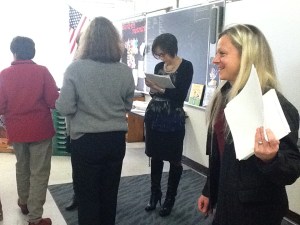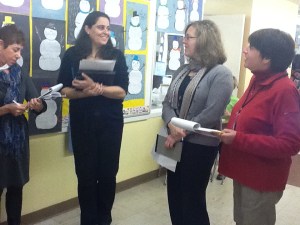What do six teachers, two members of our educational leadership team, four reflective prompts, two educational foci, one ten minute orientation, five minutes in each of seven classrooms, and one twenty minute debrief equal? A moving professional learning experience!
We set off on our school’s first teacher led learning walk armed with information from a brief orientation along with the following reflective, nonjudgmental statement and question prompts:
I wonder if . . .
What if . . .
I noticed . . .
How might . . .
Entering classrooms as a group of professional learners, with eyes and ears and minds wide open, we sought insight on two carefully selected foci: student engagement and differentiated instruction. We strove to witness student engagement via levels of participation, attentiveness, observable indicators of a commitment to learning, and focus on task. We looked to recognize differentiated instruction via the range and levels of learning activities and supports available, groupings of students both with the teacher and with peers and independent learning experiences in which students participate.
Our learning walk included not only observations, but also interactions. As possible we spoke with students and teachers in the classrooms we visited, asking them to reflect on their experiences. To students we queried, “How do you know if you do good work in this class?” “If you need help, where can you go?” We refined our questions in response to the specific learning activities we witnessed, asking students to explain their learning and to share and discuss work in their portfolios and notebooks. To teachers we asked questions to help us place our snapshot view of learning into the bigger story of ongoing learning in the classroom.
While we focused our attention primarily on the students, the learning environment was also part of our reflection. We “walked the walls” of the classrooms and hallways to see how visuals speak to learning: what kinds of charts and other visual aides are present and what models of good work are available to students. We explored the physical arrangement of the classroom, wondering about how the organization of space facilitates learning. We examined classroom resources such as libraries, computers and interactive whiteboards, considering whether the arrangement of books facilitates good use by students and how computers and the class interactive whiteboard are used to promote learning. We compared resources from classroom to classroom, pondering whether adequate resources are equally accessible to all students.
After each visit, potent and meaningful, came the heart of the learning walk experience: the hallway huddle. We gathered outside the classroom and crafted thought-provoking, reflective questions and wonderings, aimed not to offer feedback to those visited, but to spark walkers’ thinking about our own teaching and our own students’ learning. Some examples of questions and wonderings included: I wonder how the teachers’ assessment of student learning will be used to guide further learning. I wonder if students in my own class could answer questions about the purpose of instruction. What are alternative ways in which the interactive whiteboard could have been utilized? What if a learning strategist had not been present as a push-in classroom resource during this particular lesson? I noticed lots of interaction between students and teachers and between students and peers. I noticed the teacher asking “what do you think?” questions. How might seating arrangements impact how students seek assistance from each other? How might different layouts of student activity sheets support learning?
As a principal, I listened, awe-struck by our teachers’ insights and their openness to reflection and learning. As if looking into a mirror, rather than observing a peers’ classroom, our wonderings and questions reflected not sage guidance we could offer others, but thoughtful musings on how we could improve our own practice. At first I was quiet, too quiet, taking in classroom experiences through the lens of our teachers, amazed by how much more I can absorb when buttressed by the perspectives of teachers than I can on my own solitary daily classroom walkthroughs.
Our courageous faculty leader, Brandi Minchillo (@MrsMinchillo) reminded me of my role as a participant, gently pointing out to both our Assistant Principal, Ilanit Cury-Hoory (@hoory1) and me that we are allowed to share. I smiled, grateful for the reminder that at times the silence of a leader is welcome and at other times it can be distancing. I jumped into the conversation as an equal, not as a supervisor, in the process gaining understanding into how I can view classrooms more reflectively along with more thoughtful ways I can phrase and communicate what I notice and wonder about on my walkthroughs.
The learning walk ended in my office with a debriefing at which we discussed take-aways and insights. We concurred that we were surprised by how much one can learn from even a five minute visit to a classroom. We remarked on how important it is to utilize prompts to formulate nonjudgmental questions and wonderings. We noted that the learning walk supported us to consider what we can change in our own practice in order to enhance learning. We recognized how enlightening it is to observe classes at each grade level, K-5.
The mandate to be nonjudgmental aside, we indulged ourselves a bit, allowing for celebration of learning occurring in our school. All noted how impressed we are by ways teachers we visited engage students and provide differentiated learning experiences. Perhaps most significant for us was our awareness that in every single classroom we visited, we saw evidence of students becoming independent learners, one of the primary school-wide goals this year associated with our reinvigorated approach to literacy learning. To our delight, we witnessed evidence of independent learning regardless of whether or not we were observing a literacy lesson. We observed teachers transferring pedagogic skill from one curricular area to learning across the disciplines.
We had prepared for the learning walk for months, explaining to teachers in both spoken and written format what would happen. Still, the reality of eight adults entering a classroom can be overwhelming and walkers expressed empathy for those observed, demonstrating sensitivity to the courage required to open the doors of one’s classroom to adult visitors. We agreed that although we were not giving feedback, teachers deserve a thank you e-mail from me.
There are seven more learning walks scheduled throughout the academic year and we plan for each teacher to have the opportunity to be a walker and for each class to be visited. As a start, we visited teachers we perceived would be among the most comfortable and selected as walkers those who had eagerly volunteered. With positive feedback from our learning walk pioneers, we hope our faculty will be reassured and enthusiastic. Our aim in implementing learning walks is to support our efforts at nurturing a self-reflective collaborative culture, breaking down the isolation teachers can experience. Learning walks are one important component of our efforts to transform our school into a learning community in which we focus relentlessly on improving student learning and in which we do so together.




Comments on: "Walking the Learning Walk" (11)
Absolutely awesome! It’s amazing that we do similar things in our schools, its really great to hear how its working for you!! Keep up the amazing work!
Thanks, Lori! Looking forward to continuing to reflect and collaborate with you!
Shira,
The whole idea of “teacher-led learning walks” is fabulous. I don’t think you can “understate” the amount of conversations that were involved in creating this energizing learning environment. So powerful for both the observers and the teachers who were courageous and welcomed you into their rooms!
Hi Fran,
During the months of planning for our teacher led learning walks, I have benefitted from your sage insight and enthusiastic encouragement. The experience was both energizing and moving. I’ve been amazed by the changes in me as I proceed with my own daily walkthroughs since our learning walk last week. The self-reflective collaborative process has enabled me to recognize more than I had been able to see on my own. My next step is to share with our teachers how the experience touched me and how I hope to give feedback in a format more valuable for self-reflection moving forward.
Thanks so much for all of the conversation and collaboration!
Shira,
I often feel like an owl in a classroom with my head swiveling almost in a full circle as I try to absorb everything! The learning environment is so critical for promoting independence for students and I am in awe of the teachers who can truly have student-centered classrooms where the students are responsible for themselves and their surroundings.
But as a professional development provider, I also reflect on how much better teachers’ personal implementation of their adult learning is evidenced in student learning. The days of requiring a log of “x number of vocabulary activities” are painful memories!
We are truly co-constructing our definition of “quality instruction” and it’s a wonderful journey!
Hi Fran,
You’ve given me a brand new image of the principal or instructional coach on a walkthrough: an owl, head swiveling full circle! I love the image! Disciplining myself to write feedback on my daily walkthroughs in our learning walk phrases helps: I wonder if . . . What if . . . I noticed . . . How might . . . The nonjudgemental prompts support me to see deeper, opening my vision to take in more of what I am striving to absorb. I feel so proud to recognize evidence of classrooms that are more student-centered than they were before, with students developing independent skills and a sense of responsibility for their own learning. I am coming to understand better than I had before how learning grows more from our questions than from our answers. A result of our learning walk is so many more potent questions. I look forward to continuing to ask them together!
[…] some of the posts I’ve read on this topic: Teachers Observing Teachers: Instructional Rounds Walking the Learning Walk Engaging Teachers in Instructional Rounds Don’t worry, this isn’t something we’re […]
Thanks, Jessica! Brainstorming with you ways of being present for teachers continuously helps extend and deepen my thinking. Thanks for sharing these resources.
[…] Walking the Learning Walk […]
Thanks for sharing your story. As a future building leader I am finding a lot of benefits to the learning walk process. Researching the topic is how I found your blog. I notice that your post came Jan 2012 so I am interested in what it looks like a year later?
Hi Brandon,
We have continued the process of learning walks and they look quite similar to the way they are described in this post. We continue to enter one class per grade, and the class of one of our specialists and use nonjudgmental learning prompts: I notice, I wonder, what if?, how might? Our foci for the year continue to be student engagement and differentiation. I suppose what has changed is the depth of conversation at the end of the learning walk, indicating the reflective learning culture that is evolving in our school. Our next step is to create a one page focus on ways to support student learning, developed collaboratively by our faculty. That one page focus will shape professional learning, including the learning walks, moving forward. The process of getting out of our own classrooms (or for admin getting out of our offices) and viewing learning collaboratively has helped us break down isolation and has supported the development of a far more collaborative culture in our school. I’m so glad you found this post and look forward to continuing to learn together!